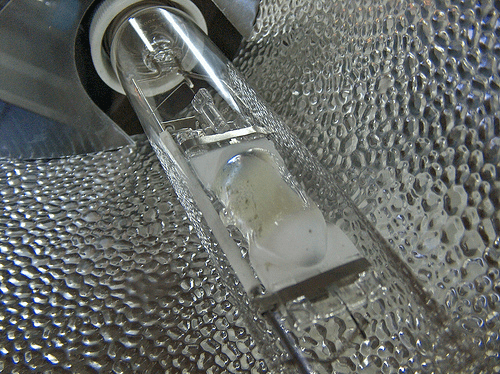High Intensity Discharge Lamps Information
 High intensity discharge lamps contain compact arc tubes that enclose various gases and metal salts. They operate at relatively high pressures and temperatures. High intensity discharge (HID) is a general term for mercury, metal halide, and high-pressure sodium lamps. Mercury lamps operate at a relatively high pressure and temperature. Most of the light is produced by radiation from excited mercury vapor. With some mercury lamps, phosphor coatings are used to provide additional light and improve color rendering. Metal halide lamps are high intensity discharge lamps that produce light using radiation from mercury and from halides of metals such as sodium, scandium, indium, and dysprosium. A metal halide lamp may have a phosphor coating. Sodium lamps are high intensity discharge lamps that produce light by electrical discharge through sodium vapor. Similarly, Xenon lamps are HID light sources that produce light by electrical discharge through xenon vapor. Like mercury lamps, sodium lamps and xenon lamps operate at relatively high pressures and temperatures. A flash lamp is an HID lamp for pulsed operation. Flash rate is the number of times per second that flash lamps are designed to fire.
High intensity discharge lamps contain compact arc tubes that enclose various gases and metal salts. They operate at relatively high pressures and temperatures. High intensity discharge (HID) is a general term for mercury, metal halide, and high-pressure sodium lamps. Mercury lamps operate at a relatively high pressure and temperature. Most of the light is produced by radiation from excited mercury vapor. With some mercury lamps, phosphor coatings are used to provide additional light and improve color rendering. Metal halide lamps are high intensity discharge lamps that produce light using radiation from mercury and from halides of metals such as sodium, scandium, indium, and dysprosium. A metal halide lamp may have a phosphor coating. Sodium lamps are high intensity discharge lamps that produce light by electrical discharge through sodium vapor. Similarly, Xenon lamps are HID light sources that produce light by electrical discharge through xenon vapor. Like mercury lamps, sodium lamps and xenon lamps operate at relatively high pressures and temperatures. A flash lamp is an HID lamp for pulsed operation. Flash rate is the number of times per second that flash lamps are designed to fire.
Specifications
Performance specifications for high intensity discharge lamps include:
- spectral distribution
- rated average life
- lamp power
- initial lumens
- mean lumens
- color rendering index
- color temperature
Spectral distribution is the wavelength range of the lamp. The rated average life refers to the lamp burning hours to median life expectancy. The lamp power specifies the wattage of the lamp. Initial lumens are the initial light output. Mean lumens is the average lamp output over a designated amount of time, usually 40% to 50% of rated lamp life. A lumen is the international (SI) unit of luminous flux or quantity of light. The color rendering index is an indication of the ability of the lamp to render object colors in a normal, natural way. Higher numbers indicate better color appearance. Numbers range from 0 to 100. Color temperature is a measure of the visual "warmth" or "coolness" of light from a high intensity discharge lamp. The higher the value, the whiter or "cooler" the light appears. Additional specifications to consider when selecting high intensity discharge lamps include maximum overall length and light center length.
Types
High intensity discharge lamps use many different types of bases:
- medium
- medium skirted
- admedium
- admedium skirted
- mogul
- base restricted mogul
- position oriented mogul
- recessed single contact
The term "skirted" means that the base flares out at the top. G-12 and PG-12 lamp bases are also available. The medium base is the standard household base for lamps up to about 300 W. Medium bases are also used for a few mercury and sodium lamps under 100 W. Admedium is halfway between a medium based and a mogul screw base. Mogul bases are used for most mercury, metal halide, and sodium lamps. They are also used for incandescent lamps over 300 W. Lamps requiring more than 200 V are more likely to have a mogul (or larger) base instead of a medium base.
Related Information
Electronics360—LEDs Address Concerns of Efficient Street Lighting
Engineering360—NEMA Publishes Roadway and Lighting Standard
Image credit:
joaomrt / CC BY-SA 2.0
